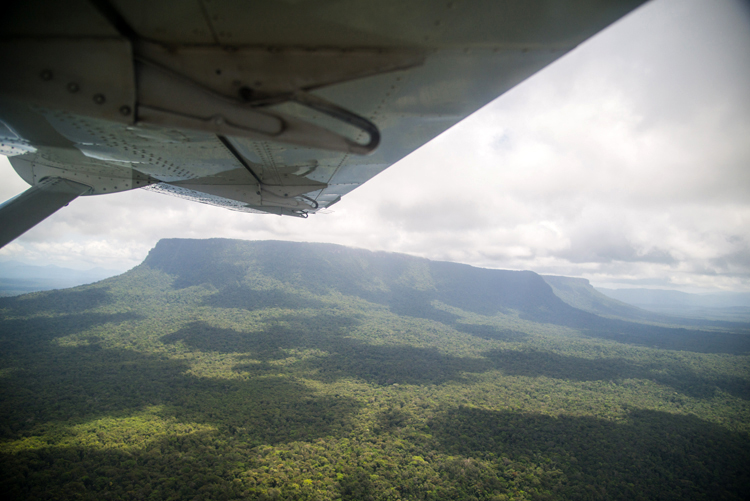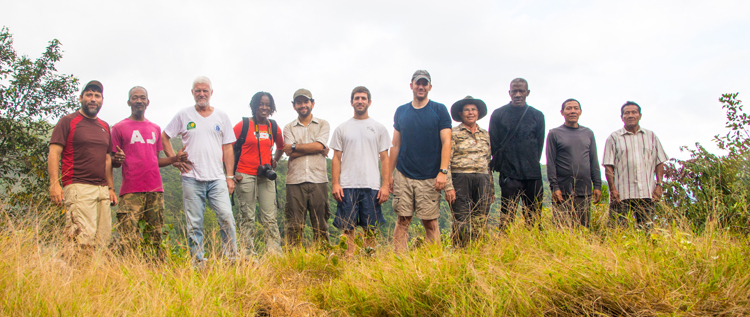An Expedition to Tafelberg: The Lore and Allure of “Table Mountain”
Posted in Travelogue on January 24, 2014 by Fabian Michelangeli
Fabian A. Michelangeli, Ph.D., is an Associate Curator of the Institute of Systematic Botany at The New York Botanical Garden. His research focuses in part on the evolution, identification, and classification of neotropical plants. This is the first of four posts about an expedition last year to Suriname in northeastern South America.

As a field biologist, you see some places mentioned in old literature that have achieved classical status, places that you think you will never be able to visit. Until recently, Tafelberg—Dutch for “table mountain”—in central Suriname was one of those places for me.
Geologically, Tafelberg is part of the Roraima formation of northeastern South America, with a layer of sandstone that lies over a granitic base, similar to several mountains in southern Venezuela that are of a type usually called a tepui (from the word for “mountain” in the language of the indigenous Pemon people). Tepuis often have steep rock cliffs that rise from the surrounding forest or savannas, giving these mountains not only their characteristic table-top shape but also a sense that their summits are effectively isolated. This shape and sense of isolation were prominently featured in Arthur Conan Doyle’s novel The Lost World, contributing to the lore and mystery that surround these mountains.
Among tepuis, Tafelberg is particularly interesting because it is the eastern-most of these fascinating mountains, and it is nearly 200 miles from the nearest tepui to the west, so it is potentially isolated from similar environments. I started my career as a biologist working on some higher, better known tepuis, such as Roraima in the southeastern corner of Venezuela, but after I started working at The New York Botanical Garden, I saw many of the plant specimens collected by Garden scientist Basset Maguire on Tafelberg during his three-month expedition in 1944. All of this contributed to my desire to visit this mountain. And then, last year, I was unexpectedly invited to participate in an expedition to the summit of Tafelberg, led by University of Kansas entomologist Andrew Short.
To get to the summit of Tafelberg, Maguire had to travel by river 28 days and then cut a trail through savannas and forests for the next three and a half weeks. For us, the trip was much easier. We flew to an airstrip immediately south of the mountain, where we established a base camp and waited for the helicopter that would take us to the summit a couple of days later.
One exciting aspect of this trip was the diverse team that participated. We had six scientists working on a variety of organisms and spanning different institutions and stages in our careers. In addition to Andrew, the aquatic insect team also included Devin Bloom, a post-doctoral fellow in Andrew’s lab and an expert on South American fish. Paul Obouter, the director of the National Zoological Collection of Suriname, and Vanessa Kadosoe, a student at the University of Suriname, were in charge of collecting herpetological specimens—frogs and reptiles. Lastly, joining me on the botany team was Julian Aguirre, a graduate student at the City University of New York whom I am advising on his dissertation about bromeliads. Joining the six of us was a great team of five people who provided logistical support, such as cooking, camp-building, trail-cutting, and serving as guides.

Although the main objective of the expedition was the summit of Tafelberg, we took advantage of our stay at the bottom of the mountain. Within minutes of landing, we started collecting plants that grow in very different environments: white sand savannas, Mauritia palm swamps, flooded forests, and non-flooded forests. These collections from the surrounding lowlands would be a great point of comparison to assess how different the vegetation of the summit was.
We were ready to head to the summit. However, as I’ll describe in my next post, getting to the top of the mountain meant moving not just us but all of our gear.
The expedition to Tafelberg was funded by a grant to Andrew Short from the National Geographic Society.

